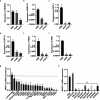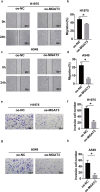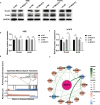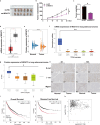Downregulation of MGAT3 Promotes Benzo[ a]pyrene-Mediated Lung Carcinogenesis by Regulating Cell Invasion and Migration Activity
- PMID: 40352502
- PMCID: PMC12060035
- DOI: 10.1021/acsomega.4c10682
Downregulation of MGAT3 Promotes Benzo[ a]pyrene-Mediated Lung Carcinogenesis by Regulating Cell Invasion and Migration Activity
Abstract
Environmental chemical carcinogens are major factors in the induction of lung cancer, with benzo[a]pyrene (B[a]P) being one of the most widespread and highly carcinogenic among them. Although studies have reported that B[a]P exerts its carcinogenic effects by causing mutations, inducing cytotoxicity, and inhibiting DNA synthesis, the early molecular regulatory events and mechanisms involved in B[a]P-induced tumor initiation remain unclear. This study found that the MGAT3 gene was significantly downregulated in B[a]P-induced mouse lung tumorigenesis, suggesting its important tumor-suppressive function. Further investigation revealed that suppression of MGAT3 expression promoted the invasion and migration abilities of lung cancer cells, while overexpression of MGAT3 in these cells inhibited these effects. Western blot analysis also showed that MGAT3 regulated the expression of epithelial-mesenchymal transition markers, thereby affecting the motility of lung cancer cells. Xenograft assay also confirmed the inhibitory effect of MGAT3 overexpression on tumor proliferation. Analysis of lung cancer tissue expression further validated that MGAT3 is significantly downregulated in lung cancer tissues, and this decrease in expression is associated with a poor prognosis in lung cancer patients. Our research indicates that the suppression of MGAT3 expression and its downstream regulatory molecules plays a crucial role in lung cancer development induced by environmental chemical carcinogens.
© 2025 The Authors. Published by American Chemical Society.
Conflict of interest statement
The authors declare no competing financial interest.
Figures






Similar articles
-
Suppression of MGAT3 expression and the epithelial-mesenchymal transition of lung cancer cells by miR-188-5p.Biomed J. 2021 Dec;44(6):678-685. doi: 10.1016/j.bj.2020.05.010. Epub 2020 May 23. Biomed J. 2021. PMID: 35166206 Free PMC article.
-
Exosomal miR‑663b exposed to TGF‑β1 promotes cervical cancer metastasis and epithelial‑mesenchymal transition by targeting MGAT3.Oncol Rep. 2021 Apr;45(4):12. doi: 10.3892/or.2021.7963. Epub 2021 Mar 2. Oncol Rep. 2021. PMID: 33649791 Free PMC article.
-
Circ_0070934 promotes MGAT3 expression and inhibits epithelial-mesenchymal transition in bronchial epithelial cells by sponging miR-199a-5p.Allergy Asthma Clin Immunol. 2024 Mar 23;20(1):23. doi: 10.1186/s13223-024-00890-y. Allergy Asthma Clin Immunol. 2024. PMID: 38521909 Free PMC article.
-
Benzo[a]pyrene at human blood equivalent level induces human lung epithelial cell invasion and migration via aryl hydrocarbon receptor signaling.J Appl Toxicol. 2020 Aug;40(8):1087-1098. doi: 10.1002/jat.3969. Epub 2020 Mar 12. J Appl Toxicol. 2020. PMID: 32166782
-
Benzo(a)pyrene regulated A549 cell migration, invasion and epithelial-mesenchymal transition by up-regulating long non-coding RNA linc00673.Toxicol Lett. 2020 Mar 1;320:37-45. doi: 10.1016/j.toxlet.2019.11.024. Epub 2019 Nov 25. Toxicol Lett. 2020. PMID: 31778776
References
-
- International Agency for Research on Cancer, World Health Organization . World Cancer Report, 2014. http://globocan.iarc.fr (accessed Feb 3, 2014).
-
- Chen W.; Padilla M. T.; Xu X.; Desai D.; Krzeminski J.; Amin S.; Lin Y. Quercetin Inhibits Multiple Pathways Involved in Interleukin 6 Secretion from Human Lung Fibroblasts and Activity in Bronchial Epithelial Cell Transformation Induced by Benzo[a]pyrene Diol Epoxide. Mol. Carcinog. 2016, 55 (11), 1858–1866. 10.1002/mc.22434. - DOI - PubMed
-
- Mallah M. A.; Changxing L.; Mallah M. A.; Noreen S.; Liu Y.; Saeed M.; Xi H.; Ahmed B.; Feng F.; Mirjat A. A.; Wang W.; Jabar A.; Naveed M.; Li J. H.; Zhang Q. Polycyclic Aromatic Hydrocarbon and Its Effects on Human Health: An Overview. Chemosphere 2022, 296, 133948.10.1016/j.chemosphere.2022.133948. - DOI - PubMed
LinkOut - more resources
Full Text Sources
